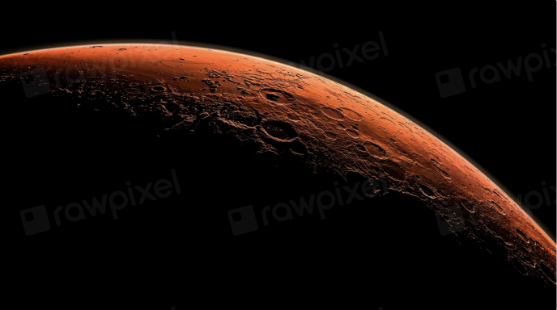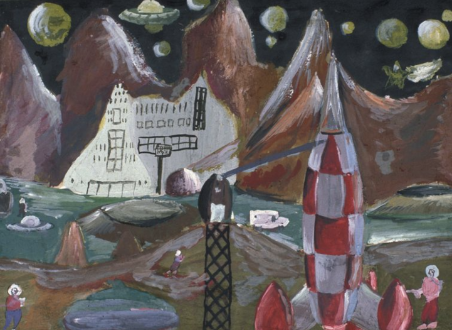Today In History: Mariner 9 Departs for Mars

For thousands of years it was only a blood-red dot among the starry host -- a nameless denizen of the trackless night. Sometimes, when it veered closer to the Earth and shone like a burning coal in the darkness, it must have roused terror among primitive sky watchers, only to fade away into relative obscurity and be forgotten once more. By the time the Egyptians settled their civilization along the banks of the Nile, it had become familiar enough to receive a name -- Har Decher, the Red One. The Babylonians referred to it as Nergal, the Star of Death, and the Greeks too associated it with warfare and bloodshed -- it was the Fiery One or the war god, Ares -- one and the same with the Roman god Mars. -- William Sheehan, "Motions of Mars", The Planet Mars: A History of Observation and Discovery, p.3.
Did you know that the fourth planet from the Sun, known as Mars, has the largest dust storm and the tallest mountain in the solar system; a thin atmosphere composed mainly of carbon dioxide; and ancient cratered highlands, similar to the Moon? With its low pressure and low surface gravity, you certainly could not survive without a high-end space suit, though you could jump three times higher than you could on Earth. Why are humans so curious about life on Mars? What would it take to get us there? As long as we continue to put our own plant at risk, is colonizing Mars the solution to human survival?
On May 30th, 1971, a robotic spacecraft named Mariner 9, part of the NASA Mariner program, launched from Cape Canaveral, Florida. It reached the planet on November 14th of the same year -- significantly contributing to scientific research -- and becoming the first ship to orbit another planet, while beating the Soviet probes in the race to Mars. Weighing in at 2,200 pounds, Mariner 9 continued studies of the atmosphere undertaken by Mariner 6 and 7, while the equally hefty Mariner 8 failed in its launch due to a malfunction in its flight control system.
A steady surviver of dust storms and a long arduous journey, Mariner 9 mapped 85% of the Martian surface and sent back more than 7,000 pictures, including images of Olympus Mons, Valles Marineris, and the moons Phobos and Deimos.
From the summer of 2017 to spring, 2018, the Gottesman Libraries staged Mars Mission, “an out-of-this-world immersive experience” in the Smith Learning Theater of Teachers College, Columbia University. The 70 minute production simulated a mission to the Red Planet during which participants, divided into teams, worked together to solve problems of human settlement on Mars, from the scientific to the technical.
The following articles are drawn from Proquest Historical Newspapers, which informs and inspires classroom teaching and learning.
- Mariner 9 Shot to Mars Is Postponed Till Tonight. (1971, May 30). New York Times (1923-)
- Mariner 9 Heading for Orbit of Mars; Launching Is 'Good'. (1971, May 31). New York Times (1923-)
- O'Toole, T. (1971, May 31). Mariner Lifts Off to Mars: Photo Craft Races Pair of, Soviet Ships. The Washington Post, Times Herald (1959-1973)
- U.S., Soviet Agree to Share Mars Data. (1971, Oct 21). New York Times (1923-)
- Mars Flight Gets Off to Good Start: Mariner 9 Will Sped 247 Million Miles, Orbit November 14. (1971, May 31). The Sun (1837-)
- Wilford, J. N. (1971, Nov 11). Mariner Taking Its First Detailed Photos of Mars. New York Times (1923-)
- Wilford, J.N. (1971, Nov 13). Mariner 9 Ready to Orbit Mars Tonight. New York Times (1923-)
- Mariner 9 Goes Into Mars Orbit: Arrives Ahead of Soviet Craft. (1971, Nov 14). The Hartford Courant (1923-)
- Wilford, J.N. (1971, Nov 14). Mariner 9 Placed in Orbit of Mars: Unmanned Craft with a TC Camera is First Instrument to Circle Another Planet. New York Times (1923-)
- O'Toole, T. (1971, Nov 14). U.S. Orbits Mars; Soviets Hope to Land: Mariner 9 Enters Its Orbit of Mars. The Washington Post, Times Herald (1959-1973)

Tips:
- Bell, Jim. Postcards from Mars : The First Photographer on the Red Planet. New York: Plume, 2010. Curriculum ; QB641 .B45 2010.
- Let’s Explore Mars. 2015. Neward, DE: Speedy Publishing LLC, 2015. Juvenile ; QB641 .O76 2015.
- Petranek, Stephen L. How We’ll Live on Mars. First TED Books hardcover edition. New York, NY: TED Books, Simon & Schuster, 2015. Curriculum ; TL795.7 .P48 2015.
- Rusch, Elizabeth. The Mighty Mars Rovers : The Incredible Adventures of Spirit and Opportunity. Boston: Houghton Mifflin Books for Children, 2012. Curriculum ; QB641 .R87 2012.
- Seedhouse, Erik. Martian Outpost : The Challenges of Establishing a Human Settlement on Mars. Berlin ; Springer, 2009. Curriculum ; TL795.7 .S44 2009.
- Sheehan, William. The Planet Mars : A History of Observation & Discovery. Tucson: University of Arizona Press, 1997. Curriculum ; QB641 .S484 1996.
- Scientific American. Exploring Mars. 1st ed. New York: Rosen Publishing Group, 2023. e-book.
- Soare, Richard, Susan Conway, and Stephen M Clifford. Dynamic Mars : Recent and Current Landscape Evolution of the Red Planet. San Diego: Elsevier, 2018. e-book.

Images:
- Computer-Generated View of Mars, Courtesy of Rawpixel.
- Poster Image: Mariner 9, Courtesy of Wikimedia.
- K. Mathieu. Planet Mars, Luxembourg, 1955. From The Ziegfeld Collection of International Children's Art, Courtesy of Teachers College, Columbia University.
Need to keep current, look to the past, teach a topic? The Everett Cafe features daily postings of news from around the world, and also promotes awareness of historical events from an educational context. Be sure to check additional Cafe News postings on the library blog.

